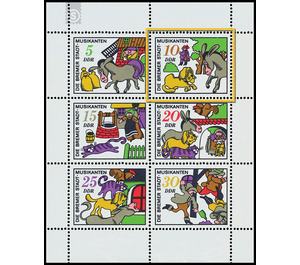Commemorative stamp series - Germany / German Democratic Republic 1971
Theme: Animals
| Country | Germany / German Democratic Republic |
| Issue Date | 1971 |
| Color | multi-colored |
| Item Type | Sheet |
| Chronological Issue Number | 1460 |
| Chronological Chapter | GER-DDR |
| SID | 6188 |
| In 19 Wishlists | |
German Fairy Tales, Edition 1971 The Ministry of Posts and Telecommunications of the German Democratic Republic publishes six multi-colored special postage stamps with illustrations from the German fairy tale "The Bremen Town Musicians". The six stamps are printed on a miniature sheet. No special First Day Cover Cover The Bremen Town Musicians The fairy tale "The Bremen Town Musicians" is one of the most famous and popular folk fairy tales. It shows in a dramatic-comic way what the solidarity of the weak can do, it strengthens the compassion for the oppressed creature and promotes the sense of justice. "The Bremen Town Musicians" were not included in the original collection of the children's and house fairy tales of the Brothers Grimm of 1812. Only in the second revised edition of 1819 it appeared as number 27 instead of the fairy tale "The death and the goose-shirt". It comes from two stories from the Paderborn. The oldest examples of this fairy tale are the Latin epic "Ysengrim" written around 1148 by the Ghent master Nivardus and the "Roman de Renart", also written in France in the 12th century. Roe deer, deer, goat, ram, donkey, fox, gander and rooster go to Rome in "Ysengrim". When staying in a hospice, the wolf wants to sneak into her confidence. However, with wisdom and cunning they drive him away. In the "Roman de Renart" Aries and donkeys are travel companions of the fox on their way to Rome. They enter the empty house of wolves. When they return home, they are duped by the three animals. With only minor modifications, the fairy tale was also known in Austria, Bohemia, Thuringia and Holstein. In Hanover, Transylvania and the Samland, the role of the robbers was also taken over by wolves. A similar version is also the master song "The Kecklein unter wolves" by Hans Sachs (1551) based. Cat, ox, horse and cock spend the night in an empty house. The inhabitants, two wolves, hear the crows of the rooster when they return home. The one, called Kecklein, is forwarded. He is mauled by the animals and reports. Also Georg Rollenhagen reported in 1571 in a doctrinal poem of a similar story. Motifs of this fairy tale can be found in almost all European languages: in Dutch, Flemish, Danish, Swedish, Norwegian, English, French, Italian, Portuguese, Romanian, Bulgarian, Slovenian, Serbo-Croat, Czech, Polish, Russian, Latvian, Hungarian, Finnish and others. Even from Syria, from Sumatra, Algeria are known related fairy tales with the corresponding native species. The most important episodes of the fairy tale are arranged in the stamp series as follows: A miller decides to put an end to his donkey's life because he has spent his energy in years of hard labor (5-pfennig value). The clever ass, however, guesses the intention and runs away. On his way he meets a hunting dog, which his master wanted to life (10-pfennig value). They decide to move together to Bremen to earn their living there as city musicians, then they meet an old cat, whose mistress wanted to drown her (15-pfennig value). The cat joins them. On a farm, a cock screams very miserably. He should walk in the soup pot (20-pfennig value). The three take him into their community. When it gets dark, they come to a house in the woods. They want to stay overnight there. However, they discover that there are robbers in the most beautiful colliery. To drive them away, the dog climbs on the donkey, the cat on the dog, the cock on the cat, and they start a terrible concert (25-pfennig value). Then they jump through the window and drive away the horrified robbers (30-pfennig value), who believe that the ghosts have come upon them. Late at night, the robbers send out a scout, but the cat, dog, donkey and cocker is so badly prepared that he hurries to seek the distance and with him the robbers.


